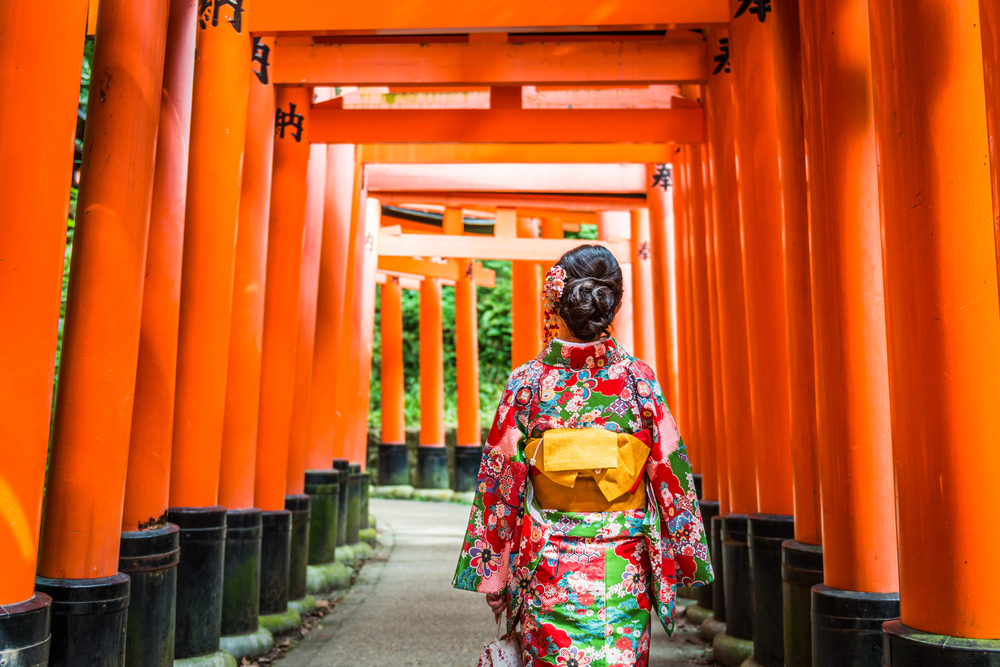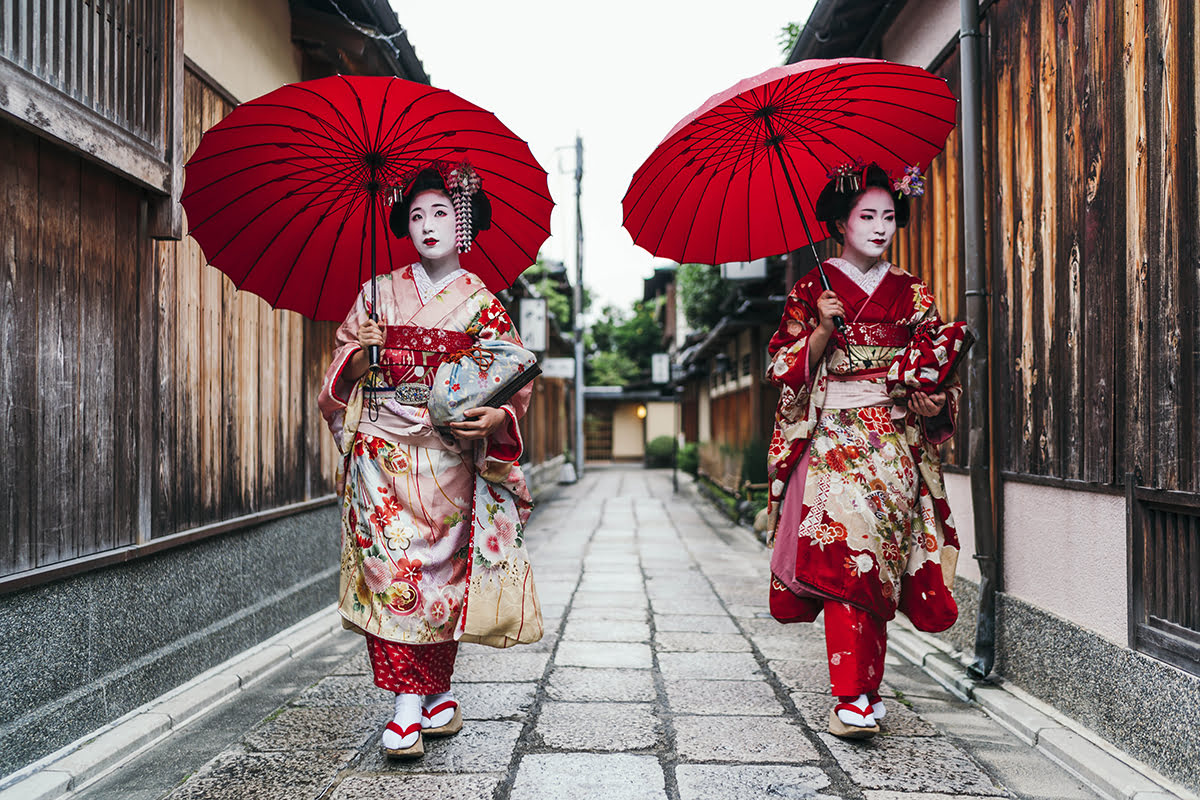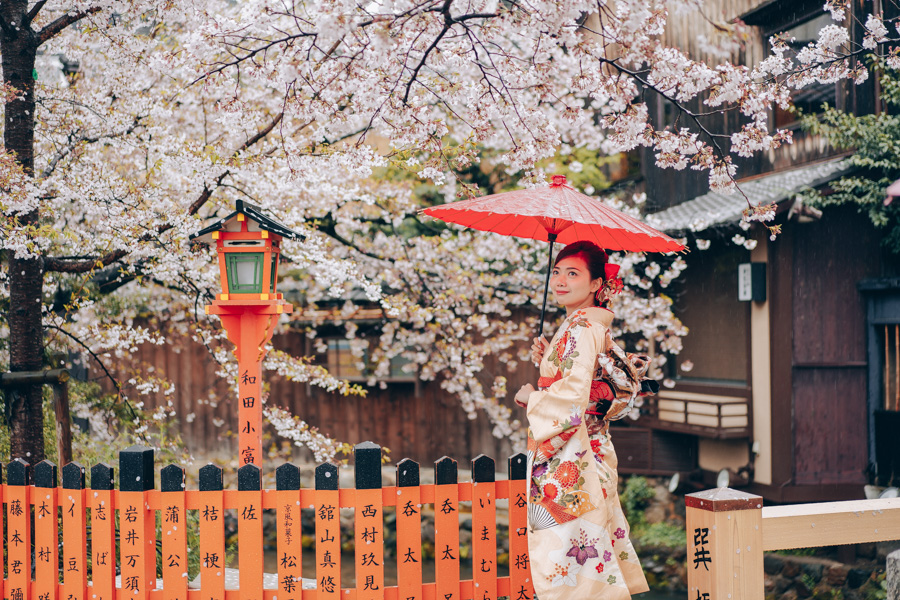15 Stunning Kimono Photo Ideas in Kyoto
(Perfect for Solo Travelers)
Discover breathtaking kimono photography opportunities in Japan’s ancient capital, whether you’re traveling alone or with companions

Traditional kimono photography combining cultural elegance with Kyoto’s natural beauty
- Introduction: Capturing Kyoto’s Timeless Beauty in Kimono
- Why Kyoto is the Ultimate Destination for Kimono Photography
- 15 Creative Kimono Photo Ideas for Your Kyoto Adventure
- 1. Classic Temple Gate Portrait
- 2. Bamboo Grove Wanderer
- 3. Traditional Tea House Setting
- 4. Cherry Blossom Garden Romance
- 5. Zen Garden Meditation
- 6. Riverside Reflection Shots
- 7. Mountain Vista Overlook
- 8. Traditional Market Scene
- 9. Stone Lantern Pathway
- 10. Seasonal Festival Documentation
- 11. Geisha District Atmosphere
- 12. Garden Bridge Crossing
- 13. Snow-Covered Temple Grounds
- 14. Sunset Silhouette Portraits
- 15. Indoor Cultural Space Portraits
- Professional Photography Services in Kyoto
- Planning Your Kimono Photography Experience
- Cultural Etiquette and Respect
- Technical Photography Tips for Kimono Portraits
- Post-Processing and Sharing Your Kimono Photos
- Creating Lasting Memories Through Kimono Photography
Introduction: Capturing Kyoto’s Timeless Beauty in Kimono
Kyoto, Japan’s former imperial capital, offers an unparalleled backdrop for kimono photography that seamlessly blends traditional Japanese culture with stunning architectural beauty. Whether you’re a solo traveler seeking memorable photos or planning a group photoshoot, wearing a kimono in Kyoto creates magical moments that capture the essence of Japanese heritage.
The ancient city’s preserved temples, bamboo groves, and historic districts provide countless opportunities for breathtaking kimono portraits. From the iconic vermillion torii gates of Fushimi Inari to the serene bamboo forests of Arashiyama, Kyoto’s diverse landscapes ensure every kimono photo tells a unique story of Japanese tradition and natural beauty.
Professional kimono photography in Kyoto has become increasingly popular among tourists and locals alike, offering an authentic way to connect with Japanese culture while creating lasting memories. This comprehensive guide presents 15 creative kimono photo ideas that will elevate your Kyoto experience, regardless of whether you’re exploring solo or with companions.

Kiyomizu-dera temple offers iconic wooden architecture perfect for kimono photography
Why Kyoto is the Ultimate Destination for Kimono Photography
Historical Significance and Cultural Authenticity
Kyoto served as Japan’s capital for over 1,000 years, making it the most culturally significant city for traditional Japanese experiences. The city houses over 2,000 temples and shrines, 17 UNESCO World Heritage sites, and countless traditional neighborhoods that have remained virtually unchanged for centuries.
When you wear a kimono in Kyoto, you’re not just dressing up for photos – you’re participating in a living tradition that connects you to generations of Japanese history. The streets of Gion, where geishas still walk to their appointments, and the temple grounds where ceremonies have been held for over a millennium, provide authentic settings that modern cities simply cannot replicate.
Diverse Photography Locations
Kyoto’s compact size belies its incredible diversity of photogenic locations. Within a single day, you can capture kimono photos against:
- Ancient temple complexes with intricate wooden architecture
- Vibrant bamboo forests that create natural green tunnels
- Traditional Japanese gardens with carefully manicured landscapes
- Historic streets lined with traditional machiya (wooden townhouses)
- Scenic riverside paths along the Kamogawa River
- Mountain vistas that change dramatically with the seasons
This variety ensures that your kimono photoshoot in Kyoto will yield a diverse portfolio of images, each capturing different aspects of Japanese aesthetic beauty.
Arashiyama bamboo grove provides ethereal natural tunnels perfect for kimono portraits
Seasonal Photography Opportunities
Kyoto’s four distinct seasons each offer unique kimono photography opportunities:
Spring (March-May): Cherry blossoms create pink canopies that perfectly complement colorful kimono designs. The contrast between delicate sakura petals and elegant kimono patterns creates some of the most sought-after photos in Japanese tourism.
Summer (June-August): Lush green landscapes and vibrant festivals provide dynamic backdrops. Summer kimono, known as yukata, offer lighter fabrics and bright patterns perfect for outdoor photography.
Autumn (September-November): Maple leaves in brilliant reds and golds create stunning natural frames for kimono portraits. The warm colors of autumn foliage harmonize beautifully with traditional kimono color palettes.
Winter (December-February): Snow-covered temple roofs and frost-kissed gardens provide serene, minimalist backdrops that emphasize the elegance of kimono silhouettes against winter’s stark beauty.

Spring cherry blossoms create magical backdrops for kimono photography in Kyoto
15 Creative Kimono Photo Ideas for Your Kyoto Adventure
1. Classic Temple Gate Portrait
Position yourself beneath one of Kyoto’s iconic temple gates, such as those at Kiyomizu-dera or Chion-in Temple. The massive wooden structures create natural frames that emphasize the traditional elements of your kimono while showcasing Japan’s architectural mastery.
Photography Tips: Use the gate’s vertical lines to create symmetry in your composition. Early morning light filtering through the wooden beams creates dramatic shadows that add depth to your kimono photos.
Best Locations: Kiyomizu-dera’s Niomon Gate, Chion-in’s Sanmon Gate, Nanzen-ji’s Sanmon Gate
2. Bamboo Grove Wanderer
The Arashiyama Bamboo Grove offers one of the most Instagram-worthy locations for kimono photography in Kyoto. The towering bamboo creates natural green tunnels that filter sunlight into ethereal beams, perfect for capturing the flowing lines of a kimono.
Solo Photography Strategy: Use the bamboo grove’s natural paths to create leading lines in your composition. The vertical bamboo stalks complement the vertical lines of a kimono, creating harmonious visual balance.
Professional Tip: Visit during golden hour (early morning or late afternoon) when sunlight creates dappled patterns through the bamboo canopy.
3. Traditional Tea House Setting
Kyoto’s historic districts, particularly Gion and Pontocho, feature traditional tea houses that provide authentic backdrops for kimono photography. These wooden structures with their distinctive architecture represent the heart of Japanese hospitality culture.
Cultural Context: Many of these tea houses have operated for centuries, hosting geishas and serving traditional Japanese tea ceremonies. Photographing in these locations connects your images to deep cultural traditions.
Recommended Areas: Hanami-koji Street in Gion, Pontocho Alley, Ishibei-koji Street

Historic Gion district provides authentic traditional Japanese streetscapes for kimono photography
4. Cherry Blossom Garden Romance
During spring, Kyoto’s numerous parks and temple grounds burst with cherry blossoms, creating picture-perfect settings for kimono photography. The soft pink petals complement traditional kimono colors and patterns beautifully.
Timing is Everything: Cherry blossom season typically lasts only 1-2 weeks in early April. Plan your kimono photoshoot accordingly to capture these fleeting moments of natural beauty.
Top Cherry Blossom Locations: Maruyama Park, Philosopher’s Path, Yoshino-yama Park, Daigo-ji Temple
5. Zen Garden Meditation
Kyoto’s zen gardens, with their carefully raked gravel and strategically placed rocks, provide minimalist backdrops that emphasize the elegant simplicity of kimono design. These spaces embody Japanese aesthetic principles of balance and harmony.
Photographic Approach: Use the garden’s geometric patterns to create interesting compositions. The contrast between the kimono’s flowing fabric and the garden’s structured elements creates visual tension that enhances the overall image.
Notable Zen Gardens: Ryoan-ji Temple, Ginkaku-ji (Silver Pavilion), Tenryu-ji Temple

Traditional Japanese gardens provide serene, culturally authentic settings for kimono photography
6. Riverside Reflection Shots
The Kamogawa River, which flows through central Kyoto, offers opportunities for reflection photography. Position yourself along the riverbank to capture both your kimono and its reflection in the water, doubling the visual impact of your photos.
Technical Considerations: Use a low angle to maximize the reflection effect. Calm water conditions produce the clearest reflections, so early morning sessions often yield the best results.
Prime Locations: Gion-Shirakawa area, Pontocho riverside, Kamogawa Delta
7. Mountain Vista Overlook
Kyoto is surrounded by mountains that provide elevated viewpoints for panoramic kimono photography. These locations offer sweeping views of the city’s traditional rooflines and natural landscapes.
Hiking in Kimono: While challenging, some visitors choose to hike to viewpoints in kimono for unique photos. Consider the physical demands and choose appropriate footwear.
Accessible Viewpoints: Kiyomizu-dera’s wooden stage, Fushimi Inari’s mountain trails, Arashiyama Monkey Park
8. Traditional Market Scene
Kyoto’s traditional markets, such as Nishiki Market, provide vibrant, authentic backdrops for kimono photography. The colorful displays of traditional Japanese foods and crafts create dynamic compositions.
Cultural Immersion: These markets have served Kyoto residents for centuries. Photographing here captures the living culture that continues to thrive alongside tourist attractions.
Market Photography Ethics: Be respectful of vendors and customers. Ask permission before photographing, and consider purchasing items to support local businesses.
9. Stone Lantern Pathway
Many Kyoto temples feature pathways lined with traditional stone lanterns that create atmospheric corridors perfect for kimono photography. These lanterns, when lit in the evening, provide warm illumination that enhances the rich colors of kimono fabric.
Evening Photography: If visiting during evening hours, the lit lanterns create a romantic atmosphere that’s particularly stunning for kimono portraits.
Famous Lantern Paths: Kasuga Taisha approach, Kiyomizu-dera grounds, Nanzen-ji complex
Fushimi Inari’s vermillion torii gates create iconic tunnel effects for kimono photography
10. Seasonal Festival Documentation
Kyoto hosts numerous traditional festivals throughout the year, providing opportunities to photograph kimono within the context of active cultural celebrations. These events showcase kimono in their natural cultural habitat.
Major Festivals: Gion Matsuri (July), Aoi Matsuri (May), Jidai Matsuri (October), Hanami celebrations (April)
Festival Photography: Capture not just posed portraits but candid moments that show the kimono as part of living cultural traditions.
11. Geisha District Atmosphere
The historic geisha districts of Gion and Miyagawa-cho provide authentic settings where kimono photography connects with ongoing cultural traditions. These areas maintain the atmosphere of old Kyoto where kimono wearing was part of daily life.
Respectful Photography: Be mindful of working geishas and maikos who are not tourist attractions but working professionals. Focus on the architectural beauty and general atmosphere rather than intruding on their activities.
Architectural Features: Traditional ochaya (tea houses), wooden facades, paper lanterns, and stone-paved streets
12. Garden Bridge Crossing
Kyoto’s traditional gardens often feature ornate bridges that provide elevated platforms for kimono photography. These bridges, whether spanning ponds or dry landscapes, create natural stages for capturing the full beauty of kimono silhouettes.
Compositional Elements: Use the bridge’s lines to lead the eye toward your subject. The elevated position allows for full-body shots that showcase the complete kimono ensemble.
Garden Bridges: Ginkaku-ji garden bridges, Kinkaku-ji reflective settings, Tenryu-ji garden paths
13. Snow-Covered Temple Grounds
Winter kimono photography in Kyoto offers unique opportunities when snow blankets temple grounds and gardens. The white snow provides a clean, minimalist backdrop that emphasizes the colors and patterns of winter kimono.
Winter Kimono Considerations: Traditional winter kimono are designed for cold weather and often feature deeper colors and warmer fabrics that photograph beautifully against snow.
Snowy Locations: Kinkaku-ji (Golden Pavilion), Ginkaku-ji (Silver Pavilion), Bamboo Grove with snow

Autumn maple leaves create stunning natural frames for kimono portraits in Kyoto temples
14. Sunset Silhouette Portraits
Kyoto’s western mountains provide stunning sunset views that create opportunities for dramatic silhouette photography. Position yourself against the sunset to create striking kimono silhouettes that emphasize the garment’s distinctive shape.
Technical Approach: Expose for the sky to create true silhouettes, or use fill flash to maintain some detail in the kimono while preserving the sunset colors.
Sunset Viewpoints: Kiyomizu-dera, Yasaka Pagoda area, Arashiyama riverside
15. Indoor Cultural Space Portraits
Many of Kyoto’s temples and cultural facilities offer beautiful interior spaces for kimono photography. These indoor locations provide protection from weather while showcasing traditional Japanese interior design elements.
Interior Photography Benefits: Controlled lighting, protection from crowds, intimate atmosphere, architectural details
Notable Interiors: Temple halls, traditional ryokan lobbies, cultural centers, tea ceremony rooms
Professional Photography Services in Kyoto
For those seeking the highest quality kimono photography experience in Kyoto, professional photography services ensure expertly composed, beautifully lit images that capture both the beauty of the location and the elegance of traditional Japanese dress.
AllPhoto Kyoto specializes in creating stunning kimono photography experiences throughout Kyoto’s most photogenic locations. Their professional photographers understand both the technical aspects of photography and the cultural significance of kimono, ensuring that every image respects Japanese traditions while creating modern, shareable memories.
Professional services offer several advantages:
- Expert Knowledge: Professional photographers know the best times and angles for each location
- Cultural Sensitivity: Understanding of appropriate behavior and photography etiquette in sacred spaces
- Technical Excellence: High-quality equipment and post-processing ensure magazine-quality results
- Efficiency: Maximizing photo opportunities within limited time schedules
- Language Support: Clear communication in multiple languages for international visitors
Planning Your Kimono Photography Experience
Choosing the Right Kimono
Selecting an appropriate kimono significantly impacts your photography results. Consider these factors:
Seasonal Appropriateness: Match your kimono choice to the season and weather conditions. Spring kimono often feature floral patterns, while autumn designs incorporate maple leaf motifs.
Color Coordination: Choose colors that complement your chosen photography locations. Vibrant colors stand out against neutral backgrounds, while subtle tones work well in busy environments.
Pattern Complexity: Detailed patterns photograph beautifully in close-up portraits, while simpler designs work better for full-body shots against complex backgrounds.
Optimal Photography Timing
Golden Hour Magic: The hour after sunrise and before sunset provides the most flattering natural light for kimono photography. The warm, soft light enhances fabric colors and creates gentle shadows.
Crowd Avoidance: Popular locations are less crowded early in the morning, allowing for uninterrupted photography sessions and more intimate connections with the locations.
Seasonal Considerations: Each season offers unique advantages. Spring cherry blossoms, summer festivals, autumn foliage, and winter snow each create distinct moods for kimono photography.
Weather Contingency Planning
Kyoto’s weather can be unpredictable, so having backup plans ensures successful photography sessions regardless of conditions:
Rainy Day Alternatives: Indoor locations, covered temple corridors, traditional architecture with overhangs
Hot Weather Strategies: Early morning sessions, shaded locations, frequent breaks, appropriate kimono fabrics
Cold Weather Preparations: Layering options, hand warmers, shorter outdoor sessions with indoor warm-up breaks
Cultural Etiquette and Respect
Sacred Space Photography
When photographing in temples and shrines, maintaining respectful behavior is essential:
Permission Protocols: Many locations require permission for professional photography. Always check local rules and respect any restrictions.
Quiet Presence: Maintain a respectful demeanor that doesn’t disturb worshippers or other visitors. Photography should never interfere with religious activities.
Appropriate Areas: Stick to designated visitor areas and avoid entering restricted sacred spaces.
Community Interaction
Local Respect: Remember that Kyoto is a living city with residents who deserve respect and privacy. Avoid blocking pedestrian traffic or creating disturbances.
Merchant Relations: When photographing near businesses, consider supporting them through purchases or polite interaction.
Cultural Appreciation: Approach kimono wearing as cultural appreciation rather than costume play. Understanding the garment’s significance enhances the experience for everyone involved.
Technical Photography Tips for Kimono Portraits
Composition Techniques
Rule of Thirds: Position key elements along imaginary lines that divide your frame into thirds, creating more dynamic compositions than centered subjects.
Leading Lines: Use architectural elements, pathways, and natural features to guide the viewer’s eye toward your kimono-clad subject.
Framing Devices: Temple gates, tree branches, and architectural elements can create natural frames that focus attention on your subject.
Lighting Considerations
Natural Light Mastery: Understanding how different types of natural light affect kimono photography helps create more professional results.
Shadow Management: Use shadows creatively to add depth and drama, but avoid harsh shadows that obscure important details.
Color Temperature: Different times of day produce different color temperatures that can enhance or clash with kimono colors.
Posing Guidance
Traditional Postures: Understanding traditional Japanese postures and gestures adds authenticity to kimono photography.
Fabric Flow: Kimono are designed to create elegant lines and silhouettes. Learn to position the fabric for maximum visual impact.
Hand Placement: Traditional hand positions and gestures complement kimono photography and add cultural authenticity.
Post-Processing and Sharing Your Kimono Photos
Digital Enhancement Techniques
Color Correction: Enhance the rich colors of kimono fabric while maintaining natural skin tones and environmental colors.
Detail Enhancement: Bring out the intricate patterns and textures that make kimono so visually stunning.
Background Optimization: Balance the relationship between subject and background to create cohesive compositions.
Social Media Optimization
Platform-Specific Formatting: Different social media platforms have different optimal image sizes and aspect ratios.
Hashtag Strategy: Use relevant hashtags that connect your photos with kimono, Kyoto, and Japanese culture communities.
Cultural Sensitivity: Share your images with respect for Japanese culture and avoid stereotypical or inappropriate representations.
Creating Lasting Memories Through Kimono Photography
Kimono photography in Kyoto offers more than just beautiful images – it provides a meaningful connection to Japanese culture and creates lasting memories of one of the world’s most beautiful cities. Whether you’re a solo traveler seeking personal documentation of your journey or part of a group celebrating a special occasion, wearing a kimono in Kyoto’s historic settings creates an immersive cultural experience that photographs beautifully.
The combination of Kyoto’s preserved historical architecture, natural beauty, and cultural significance with the elegance and tradition of kimono creates photographic opportunities that are truly unique. Each image captured becomes not just a photograph, but a moment of cultural exchange and personal transformation.
Professional photography services like AllPhoto Kyoto enhance this experience by ensuring that every technical aspect is handled expertly, allowing you to focus on enjoying the cultural immersion and creating authentic connections with this ancient city’s enduring beauty.
The memories created through kimono photography in Kyoto extend far beyond the images themselves. They represent a deeper engagement with Japanese culture, an appreciation for traditional craftsmanship, and a personal journey through one of the world’s most culturally significant destinations. These photographs become treasured reminders of the day you stepped into Japanese tradition and experienced Kyoto’s timeless beauty firsthand.

Professional kimono photography captures the perfect blend of tradition and natural beauty in Kyoto
Ready to Capture Stunning Kimono Photos in Kyoto?
Visit AllPhoto Kyoto to book your professional photography experience and create unforgettable memories in Japan’s ancient capital.



コメント